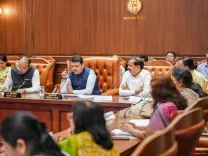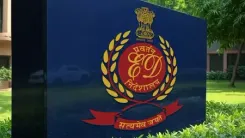Is Karnataka Responsible for the Pollution of the Thenpennai River?

Synopsis
Key Takeaways
- Karnataka is accused of contributing to pollution in the Thenpennai River.
- Over 9,000 acres of farmland are affected.
- The river is critical for irrigation and drinking water.
- Future hearings are scheduled by the National Green Tribunal.
- Both states must collaborate for sustainable solutions.
Chennai, July 16 (NationPress) The Tamil Nadu Water Resources Department (WRD) has accused Karnataka of perpetuating the pollution of the Thenpennai (South Pennar) river, attributing this to untreated sewage and industrial waste flowing from Bengaluru into Tamil Nadu.
This contamination is reportedly inflicting severe ecological harm and posing health threats in the downstream regions of the state.
In response to media reports, the Southern Bench of the National Green Tribunal (NGT) initiated a suo motu case, instructing the Tamil Nadu government to provide a report on the river's pollution levels.
In compliance with this order, WRD Secretary J. Jayakanthan submitted a comprehensive report to the Tribunal.
The report indicated that polluted discharges from Bengaluru’s Bellandur, Agara, and Varthur lakes flow downstream through Sokkarasanapalli in the Krishnagiri district and accumulate in the Kelavarapalli reservoir.
“The water entering Tamil Nadu appeared blackish and emitted a sewage-like odour. Foam and a foul smell were noticeable at the Kelavarapalli dam, with no signs of aquatic life,” the report disclosed.
The river, stretching 432 kilometers, with 320 kilometers traversing Tamil Nadu, serves as a vital water source for irrigation, drinking, and industries across five districts.
The pollution has significantly impacted agriculture on over 9,000 acres and disrupted water supply to Hosur and adjacent areas.
The WRD's report criticized Karnataka for neglecting to upgrade sewage treatment facilities and regulate polluting industries. “Without curbing industrial discharge, effective bioremediation in Tamil Nadu is unachievable,” the department cautioned.
A central negotiation committee has convened nine meetings and conducted site inspections, documenting black, foamy, and odorous water in river portions and tanks in both states. Despite repeated entreaties, Karnataka has not acted on the committee’s recommendations.
During a hearing on Tuesday (July 15), Karnataka’s attorney informed the Tribunal that 12 new sewage treatment plants (STPs) would be operational by December, with 10 more in the pipeline. However, no interim measures were proposed.
Tamil Nadu’s standing counsel D. Shanmuganathan noted that the state’s Chief Secretary had communicated with his Karnataka counterpart as early as April 2023, but no subsequent action had been taken. He also underscored Karnataka’s prior commitment in 2019 to construct STPs with a cumulative capacity of 630 MLD, which has progressed slowly.
The Tribunal has rescheduled the case for further hearing on August 21.







